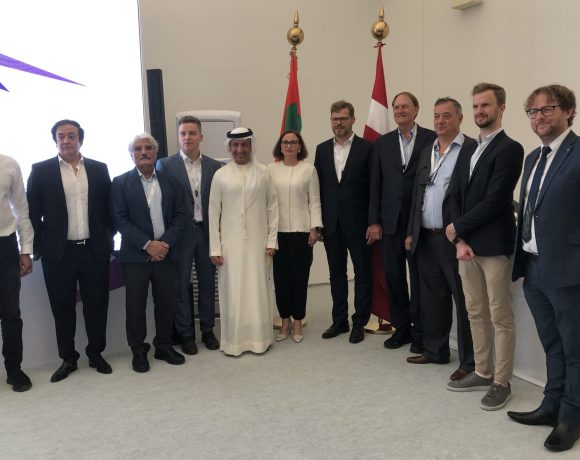Middle East’s digital economy set to touch $780bn in 2030

Software, internet, and data centres standout sectors
The latest information technology report issued by UBS – the largest global wealth manager – has identified the Middle East as the next significant digital frontier market in global tech.
The UBS AG Singapore branch and UBS Financial Services prepared and released the report, part of a TechGPT series, on August 28, 2023.
The study expects the Middle East’s digital economy to grow from $180 billion (AED2.8 trillion) in 2022 to $780 billion (AED2.8 trillion) in 2030, with an annual growth of around 20%.
This scenario would make the Middle East one of the fastest-growing digital economies globally.

The authors noted that the region’s digital economy penetration relative to GDP is anticipated to increase from 4.1% in 2022 to 13.4% in 2030, remaining below advanced economies such as the United States at around 15%.
Investment opportunities
This expansion is expected to offer investment opportunities in sectors like the internet, software (including cybersecurity), data centres, and private equity and venture capital domains.
For the report, the authors put the spotlight on why the Middle East is set to be the next digital frontier market within global tech.
Leading position
The research’s authors noted that their estimates may be conservative as the digital economy penetration as a percentage of the region’s GDP is expected to rise from 4.1% in 2022 to 13.4% in 2030, which is still below today’s 15% penetration levels in advanced economies such as the United States.

From an investment point of view, the strong growth outlook should provide solid opportunities in faster-growing Middle Eastern segments like the internet, software (including cybersecurity) and data centres, as well as exciting prospects in the private equity/venture capital space, the study reported.
From the authors’ perspective, technology stocks were likely to end August 2023 on a weaker note, even as catalysts should start to emerge in product cycles, rehiring and accelerating capex growth.
Looking beyond the near term and outside India and ASEAN’s digital economy markets, the study focused on the fast-growing tech market of the Middle East, where the authors expect a substantial 20% average annual growth.
Current state of the Middle East’s digital economy
Turning their attention to the state of the digital economy in the Middle East, the authors believe the question is best addressed by appreciating today’s technology penetration levels in the Middle East.

They also noted it is imperative to understand the two critical pillars of the digital economy: traditional IT spending and internet economy spending.
IT spending includes consumer and enterprise spending on hardware, software, and services.
In contrast, internet economy spending includes spending on key segments like e-commerce, digital advertising, online gaming, streaming services, ride-hailing, fintech, and other services.
Global digital economy
Based on data from the World Bank, Gartner, Bloomberg Intelligence, and UBS estimates, the global digital economy was close to $10.5 trillion in revenue in 2022, roughly a 10.5% penetration rate of the global economy.
In this regard, the global digital economy is expected to grow by 10.4% per annum on average during 2022–2030, reaching $23.2 trillion, mainly led by the internet economy.

Separately, based on data from the World Bank, Gartner, Bloomberg Intelligence, and UBS estimates, the size of the Middle East’s digital economy was close to $180 billion in 2022, or 4.1% of the region’s economy.
Growth potential
The Middle East digital economy’s penetration of only 4.1% versus 10.5% globally or 15% in the United States and 7.4% penetration in India (an economy with comparable size) highlights the region’s significant medium-long term growth potential.
Another way of looking at penetration rates is to compare the current size of the Middle East’s technology markets with the global levels.

Compared to the Middle East’s GDP penetration of 4.1%, its technology penetration across segments is less than 2% except for hardware (3.3%), which is understandable given the region’s mature smartphone and personal computer (PC) spending.
However, the overall low penetration rates highlight the solid long-term growth potential of the Middle East’s digital economy, including in high-margin segments like software, internet, and others in the future, which we address in the following few pieces.
Middle East digital economy opportunities
As highlighted earlier, the Middle East’s digital economy was worth $180 billion in 2022 due to significant new investments during and after the Covid-19 pandemic.
The study estimates that the Middle East is at a very early stage of the digital ascent, with the region positioned where China was 10 to 15 years ago and India five to 10 years ago when the digital inflexion began, with only 4.1% penetration of the broad economy.
Supporting parameters
Supported by favourable demographics, strong policy support, solid funding, rising innovation, and low penetration rates, the Middle East’s digital economy is projected to grow to $780 billion in 2030 or roughly 20% growth per annum.
This makes the Middle East one of the fastest-growing digital economies globally.

Considering the Middle East’s digital economy is set to grow twice as fast as the global digital economy between 2022 and 2030, based on UBS estimates, investor interest is rising sharply over the decade.
There are two ways to participate in the Middle East’s rapidly growing digital economy: investing in suitable industries or the right companies.
For sectors, the study’s authors recommend that investors consider those that can grow faster and generate higher margins.
Standout sectors
Three industries stand out here: software, internet, and data centres.

In the Middle East, software spending is expected to grow 15% per annum on average, coupled with margin improvement, which should drive strong profitability growth.
Software scope
Software is expected to be the best way to participate in the region’s ongoing digital transformation, where many traditional enterprises are likely to upgrade their IT infrastructure by driving significant investments across software like office productivity and collaboration, cloud including enterprise resource planning and other automation, and cybersecurity.
Internet scope
The study says the internet is the fastest-growing segment in the Middle East at 23.5% CAGR.
Understandably, the industry’s profitability is low today due to significant upfront investments, but with rising scale benefits and improving pricing power, substantial scope is seen for margin expansion in future.

Compared, global internet profitability in operating margins is close to 20%.
Data centres scope
Data centres are the third segment hidden under the broader hardware segment.
While it is believed the traditional hardware segment, including smartphones and PCs, should grow by low-mid single digits, in line with the more general economic growth, data centres are a bright spot within hardware given the significant uptake of cloud and strong demand for artificial intelligence (AI).
The study expects substantial investments in generative AI in the Middle East in the next few years as significant use cases in consumer and enterprise applications have been perceived.
From a company point of view, today, there are not many pure-play listed companies globally to participate in the Middle East’s booming tech story.

However, the limited options available through locally listed tech and telecom companies and global majors with decent exposure to the Middle East should provide suitable alternatives to investors.
More enormous opportunities are seen in the unlisted space through private equity/venture capital funding akin to how investors participated in China tech 15 years ago or in Indian tech five to 10 years ago.
Technology funding trends in the Middle East
According to data from CB Insights, funding for startups and unlisted companies in the Middle East hit $13.6 billion in 2022.
Reflecting the broad weakness in 2022 in the technology landscape amid rising rates, the Middle East’s funding was flat compared to 2021 (down 2.1% year-on-year, to be precise), but that was very impressive in the context of the 35% decline in global technology funding.
With four more months to end, 2023 is perceived as a challenging year given the still demanding environment for global tech funding, particularly in the first half.
Good news
But the good news is that green shoots are emerging thanks to the spiking interest around AI and hopes of a revival in key internet segments like e-commerce and digital advertising in the region.

As a result, it is seen that the Middle East is close to the bottom in tech funding as the strong growth outlook for the region’s digital economy over the decade should attract solid investor interest, including from local technology and telecom players, sovereign wealth funds, and significant global VC/PE funds over the coming quarters.
With the Middle East accounting for only 2 to 3% of international VC/PE tech funding today (based on data from CB Insights), the region’s strong 20% per annum growth outlook should attract more investments going forward, which should provide good investment alternatives for global growth-based investors beyond major listed tech companies globally.
Investing risks in the Middle East’s digital economy
The authors opined that the Middle East is not immune to the risks many global tech companies and investors face today.
Regulations are a global issue, but more so in the Middle East, as the region’s early stages of evolution may present risks around managing antitrust, competition, labour, and pricing-related regulations.
Talent challenge
Talent is another issue, as the area needs to build a robust homegrown talent base, including a solid developer ecosystem that matches other global talent pools in Silicon Valley, China, and India.
The path to profitability is another risk for investors considering investments in profitless startups in the Middle East, as there will be an ongoing tug-of-war between focus on growth and profitability, as many trade-offs have been seen.

This is not a risk specific to the Middle East, but investors should manage these issues, given that a significant increase will originate from smaller startups in the next few years.
Additionally, geopolitical tensions between the United States and China highlight the need for the Middle East to be self-sufficient.
Currently, the region relies heavily on the West for critical technologies like semiconductors and software, so challenges and opportunities are seen as the area strives to be self-sufficient.
Among all the risks, data privacy is a pressing one, given the region’s high vulnerability to cybersecurity breaches.
Data breach cost
According to data from IBM Security and Ponemon Institute, a data breach in the Middle East costs $8.07 million in 2023, up 8.2% from $7.46 million in 2022.
This is alarming given the cost in 2023 is not only well above the global average of $4.45 million, but also the increase of 8.2% is sharp compared to the global average of 2.3%.

The good news is that Middle Eastern tech companies have realised the importance of cybersecurity and are starting to step up investments, which also provides exciting investment opportunities.
In summary, given the significant growth opportunities the Middle East offers over the next decade, the investment opportunities outweigh the risks.
With the region’s digital economy growing twice as fast as the global digital economy, options are plenty.












